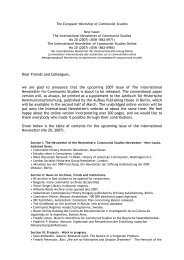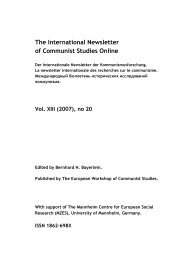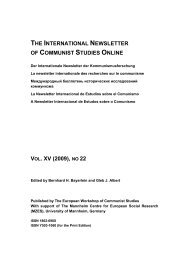The International Newsletter of Communist Studies Online IX
The International Newsletter of Communist Studies Online IX
The International Newsletter of Communist Studies Online IX
Create successful ePaper yourself
Turn your PDF publications into a flip-book with our unique Google optimized e-Paper software.
<strong>The</strong> <strong>International</strong> <strong>Newsletter</strong> <strong>of</strong> <strong>Communist</strong> <strong>Studies</strong> <strong>Online</strong> 16/2003 29<br />
opinions and estimations about the newly founded movement and the arising number <strong>of</strong> supporters <strong>of</strong> the<br />
Comintern. <strong>The</strong>re is no doubt that these were persons who were directly involved with the situation that they<br />
were examining. <strong>The</strong>refore, the first books on the history <strong>of</strong> Latin American Communism (such as »Pugnas de la<br />
gleba« by Rosendo Salazar and »Relatorio de Delegacia a Russia« by A.B. Canellas) have up until now been an<br />
important ressource for researchers as a reliable and well-documented base for studies. 10<br />
<strong>The</strong> first attempts <strong>of</strong> a methodical analysis <strong>of</strong> the history <strong>of</strong> Latin American Communism from the Marxist point<br />
<strong>of</strong> view were undertaken inside the very Comintern structures at the end <strong>of</strong> the 1920s and the beginning <strong>of</strong> the<br />
1930s. However, already the first studies made by Stanislav Pestkovsky (»A. Volsky«, »S.Ortega«), Georgiy Skalov<br />
(»Sinani«), Genrich Yakobson (»G. Ya-n«), August Guralsky, Maurice Chaskin and Vladimir Miroshevsky, despite<br />
all their worthiness, suffered from one serious deficiency, which subsequently for a long time became the<br />
Achilles heel <strong>of</strong> the Marxist historiography <strong>of</strong> the Third <strong>International</strong>. While examining the socio-economic and<br />
political development <strong>of</strong> Latin America and analyzing the genesis <strong>of</strong> Latin American Communism, the Marxist<br />
historians carefully bypassed the major question: to what extend and in what forms had the Third <strong>International</strong><br />
participated in the formation <strong>of</strong> communist parties in New World. It was to some extent a paradox as this very<br />
issue was the problem they knew best. All <strong>of</strong> these authors were working in the Latin American Country-<br />
Secretariat <strong>of</strong> the ECCI and it was they who were coordinating, for the »General staff <strong>of</strong> world revolution«, the<br />
activity <strong>of</strong> the communist parties <strong>of</strong> the continent from the Moscow headquarters <strong>of</strong> the Comintern. <strong>The</strong><br />
reasons for this attitude were mainly due to the interest which arose about Latin American Communism in the<br />
USSR which coincided with the beginning <strong>of</strong> a new stage (Stalin’s) <strong>of</strong> Comintern activity. Many <strong>of</strong> the facts<br />
which had been freely discussed before, even by the international communist media (»<strong>The</strong> <strong>Communist</strong><br />
<strong>International</strong>«, »Inprekorr«, »<strong>The</strong> Red <strong>International</strong> <strong>of</strong> the Trade Unions«), and especially in Latin American<br />
»La Correspondencia Sudamericana«, the 1920s, became taboo from this moment onwards. Culminating in<br />
the Stalinization-process <strong>of</strong> international communism, the Marxist researchers <strong>of</strong> communism became more<br />
and more reduced to the analysis <strong>of</strong> the struggle against »opportunism« and »revisionism« inside the<br />
communist movement. <strong>The</strong> organizational part <strong>of</strong> the <strong>Communist</strong> Party’s, always remained behind the<br />
framework <strong>of</strong> these studies. Thus the major consideration was ignored as it was simply impossible to analyze<br />
and describe the history <strong>of</strong> the »world communist party« (the Third <strong>International</strong>) – not only on the regional<br />
and peripheral level – without dealing with the investigation <strong>of</strong> the functioning <strong>of</strong> its organizational structure.<br />
This is the condition sine qua non in order to study the mechanism <strong>of</strong> interaction between the supreme bodies<br />
<strong>of</strong> the Comintern and its national sections.<br />
10 Many years ago, one <strong>of</strong> the authors <strong>of</strong> this review (Lazar Kheyfetz) was quite surprised by the «unlimited<br />
fantasies« <strong>of</strong> R. Salazar describing in his book the activity <strong>of</strong> a mysterious Russian agent in Mexico named<br />
«Natasha Michaelova« in 1920 (!); this fact led L. Kheyfetz to doubt about some other parts <strong>of</strong> Salazar’s study.<br />
And only after some years had passed, after reading the memoirs written by Manuel Gomez (Charles Phillips)<br />
and thanks to a scrupulous research <strong>of</strong> the Comintern archive documents which contain information about<br />
Gomez’ wife, Natalia Michailova, and her life in Mexico, the Russian historian got a chance to realize finally<br />
how precise R. Salazar was when he describedsome events <strong>of</strong> the first years <strong>of</strong> Mexican Communism.














